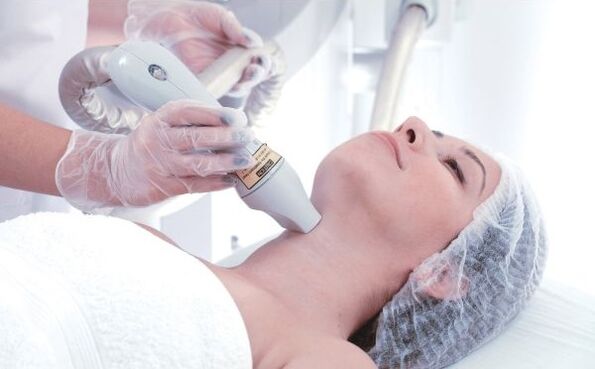Fractional photothermolysis is a procedure whose action is aimed at correcting the skin with a laser beam. The method is very effective, but traumatic and requires a rehabilitation period. Thermolysis is the destruction of cell structure by a thermal stimulus, and photothermolysis does the same thing, only with the help of light energy.
A laser beam (in the form of a thermal column) directed into the thickness of the skin creates a controlled burn, removing unnecessary skin defects. There are two methods of photothermolysis, differing in the degree of effect on the skin.

Ablative photothermolysis
This method is based on the fact that a specific laser beam is mainly absorbed by water molecules. The water contained in the tissue is heated up to 300 degrees Celsius and evaporates inside the laser column. At this point an open wound develops.
Of course, the rehabilitation process after such a procedure is quite long - at least seven days, but the effect is very noticeable. After the wound has healed, the skin is noticeably tightened and more even. It doesn't have to be done just once. The course depends on the complexity of the problem and ranges from 2 to 6 times. It is worth remembering that there is a risk of skin infection.
Non-ablative photothermolysis
This procedure is less traumatic as it is performed inside the skin without damaging the outer layer of the epidermis. Tissues are not destroyed within the entire laser beam, and all processes take place within the skin layer. The tightening effect with this method is less pronounced than with the ablation method, since the products of destruction remain in the thickness of the skin and are not brought out.
On the plus side, there is no risk of skin infection, and the rehabilitation process is fairly short - just 2-4 days. In order to achieve a good result, it is necessary to carry out from 3 to 10 procedures.
Indications for fractional photothermolysis
- Age-related skin aging, loss of turgor
- scars, including keloids
- presence of pigmentation
- The presence of stretch marks.
contraindications
- oncological diseases
- lactation
- presence of infectious diseases
- diabetes mellitus
- autoimmune diseases
- deviations of the psyche
- Recent sun exposure (tanning beds) or tanning beds
possible side effects
- infection of wounds
- Active pigmentation after the recovery period
- Microbleeds in the subcutaneous layer
- The appearance of burn blisters and cracks in the skin.
Kodi fractional laser rejuvenation is performed using special equipment in specialized facilities. Depending on which procedure is required, different types of lasers are used.
For example, to remove a scar, you need a laser that can penetrate the deeper layers of the skin (CO2 laser). And to remove pigment spots (for example, freckles or postpartum pigment spots on the skin), they are removed with an erbium laser. In order to achieve facial rejuvenation with a lasting effect, you ideally need to use several types of lasers.
It is worth paying special attention to the professionalism of the cosmetologist who will perform the procedure. Do not be shy and check the certificates for the right to perform photothermolysis, which show that the professional is trained and has certain skills and qualifications. And, of course, the most correct option would be if the procedure would be performed by a dermatologist-cosmetologist, that is, a specialist with a higher education who has been working in a clinic or beauty institute for more than a year.
























